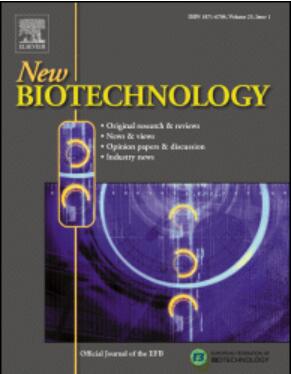Characterization and orthogonality assessment of two quorum sensing systems for synthetic biology applications
IF 4.9
2区 生物学
Q1 BIOCHEMICAL RESEARCH METHODS
引用次数: 0
Abstract
Quorum sensing systems have a broad range of applications within the field of synthetic biology. However, a bottleneck is the optimization and tuning of these systems due to the lack of standardization and complete characterization. In this research, two quorum sensing systems, namely the LasI/LasR and the EsaI/EsaR system, were fully characterized in the model host organism Escherichia coli. Furthermore, insight was gained in the interplay between the various parts of these systems. To further expand the range of possibilities with these quorum sensing systems, the orthogonality of the two systems was assessed to allow simultaneous use within the same cell without interfering crosstalk. This assessment was performed on three levels: promoter, signal and synthase crosstalk. It was demonstrated that LasR is able to interact with the promoter of the EsaI/EsaR system, albeit to a low extent. Additionally, LasR was able to respond to the autoinducers produced by EsaI. To solve the promoter crosstalk, a nucleotide change was introduced into the binding site of EsaR within the promoter region. Additionally, LasR mutants were created rationally and screened for decreased response to EsaI while retaining functionality. The best performing mutant, LasR(P117S), was further characterized. In conclusion, we have further unlocked the potential of quorum sensing systems for synthetic biology applications by obtaining two functional, characterized and orthogonal quorum sensing systems.
合成生物学应用中两种群体感应系统的特性和正交性评价
群体感应系统在合成生物学领域有着广泛的应用。然而,由于缺乏标准化和完整的特性,这些系统的优化和调优是一个瓶颈。本研究在大肠杆菌中对LasI/LasR和EsaI/EsaR两种群体感应系统进行了全面表征。此外,在这些系统的各个部分之间的相互作用中获得了洞察力。为了进一步扩大这些群体感应系统的可能性范围,对两种系统的正交性进行了评估,以允许在同一单元内同时使用而不会干扰串扰。这个评估是在三个层面上进行的:启动子、信号和合成酶串扰。结果表明,激光共振能够与EsaI/EsaR系统的启动子相互作用,但作用程度较低。此外,LasR能够响应EsaI生产的自诱导器。为了解决启动子串扰,在启动子区域内的EsaR结合位点引入了核苷酸变化。此外,合理创建LasR突变体并筛选对EsaI的反应降低而保留功能的突变体。表现最好的突变体LasR(P117S)进一步进行了表征。综上所述,我们获得了两个功能性、特征性和正交的群体感应系统,进一步释放了群体感应系统在合成生物学应用中的潜力。
本文章由计算机程序翻译,如有差异,请以英文原文为准。
求助全文
约1分钟内获得全文
求助全文
来源期刊

New biotechnology
生物-生化研究方法
CiteScore
11.40
自引率
1.90%
发文量
77
审稿时长
1 months
期刊介绍:
New Biotechnology is the official journal of the European Federation of Biotechnology (EFB) and is published bimonthly. It covers both the science of biotechnology and its surrounding political, business and financial milieu. The journal publishes peer-reviewed basic research papers, authoritative reviews, feature articles and opinions in all areas of biotechnology. It reflects the full diversity of current biotechnology science, particularly those advances in research and practice that open opportunities for exploitation of knowledge, commercially or otherwise, together with news, discussion and comment on broader issues of general interest and concern. The outlook is fully international.
The scope of the journal includes the research, industrial and commercial aspects of biotechnology, in areas such as: Healthcare and Pharmaceuticals; Food and Agriculture; Biofuels; Genetic Engineering and Molecular Biology; Genomics and Synthetic Biology; Nanotechnology; Environment and Biodiversity; Biocatalysis; Bioremediation; Process engineering.
 求助内容:
求助内容: 应助结果提醒方式:
应助结果提醒方式:


